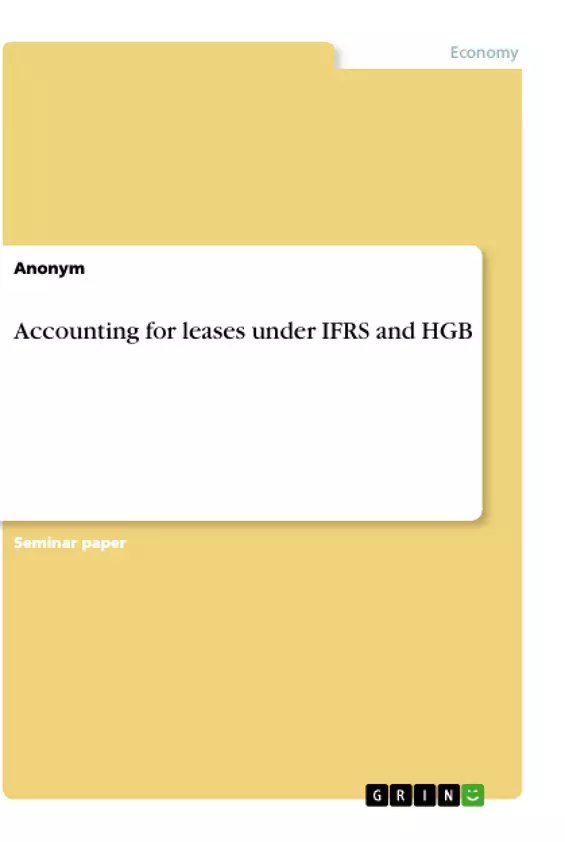The aim of this work is to show the accounting for leases under IFRS, HGB and to clarify the differences. The work devotes one main point to IFRS and one to the HGB. Each part gives an overview of the legal basics. This is followed by a classification of the leases in order to clarify the attribution of the leased object (hereinafter LO), which is relevant for the accounting. Finally, the accounting considered in detail by the lessor (hereinafter LG) or lessee (hereinafter LN). this is followed by a comparison of the approaches according to IFRS and HGB. The result concludes the work. This term paper does not deal with special leasing topics such as sales and leaseback or real estate leasing. The focus here is a simple lease, which arises, for example, when leasing a production plant.
Inhaltsverzeichnis (Table of Contents)
- Introduction
- Goal and construction of the term paper
- Accounting according to IFRS
- Classification leases under IFRS
- Finance lease
- Operating leases
- Accounting at the lessor
- Accounting at the lessee
- Accounting according to HGB
- Legal basis
- Classification Leases according to the HGB
- Operating leasing
- Finance lease
- Full payout contract
- Partial amortization contract
- Accounting at the lessor
- Accounting at the lessee
- Accounting differences between HGB and IFRS
Zielsetzung und Themenschwerpunkte (Objectives and Key Themes)
This term paper aims to analyze the accounting for leases under both IFRS and HGB, highlighting the key differences between the two accounting standards. It explores the legal basis and classification of leases under each framework, examining the accounting implications for both lessors and lessees. The paper aims to provide a comprehensive understanding of the accounting treatment of leases within the German legal and accounting context.
- Accounting for leases under IFRS and HGB
- Classification of leases as finance leases or operating leases
- Accounting treatment for lessors and lessees under both IFRS and HGB
- Key differences in accounting for leases between IFRS and HGB
- Impact of different accounting standards on financial reporting for companies.
Zusammenfassung der Kapitel (Chapter Summaries)
- Introduction: This chapter introduces the concept of leasing and its importance in the German market. It discusses the rising prevalence of leasing compared to traditional purchase models, highlighting the economic benefits of this approach. The chapter emphasizes the need for understanding different accounting regulations for leases and the complexities arising from the application of IFRS and HGB.
- Accounting according to IFRS: This chapter provides an overview of the accounting rules for leases under IFRS. It delves into the classification of leases as either finance or operating leases, outlining the criteria for determining the appropriate classification. The chapter further explains the accounting requirements for both the lessor and the lessee under IFRS.
- Accounting according to HGB: This chapter focuses on the accounting principles for leases under HGB. It examines the legal basis and classification of leases according to HGB, distinguishing between operating leases and finance leases. The chapter further analyzes the accounting requirements for both the lessor and the lessee under HGB, including the nuances associated with full payout and partial amortization contracts.
Schlüsselwörter (Keywords)
The primary focus of this term paper is on the accounting for leases under both International Financial Reporting Standards (IFRS) and Handelsgesetzbuch (HGB). Key themes include lease classification, finance leases, operating leases, lessor accounting, lessee accounting, and the comparison of accounting differences between IFRS and HGB. The paper examines the impact of these accounting standards on financial reporting for companies in the German market.
- Citar trabajo
- Anonym (Autor), 2019, Accounting for leases under IFRS and HGB, Múnich, GRIN Verlag, https://www.grin.com/document/512180



